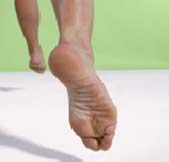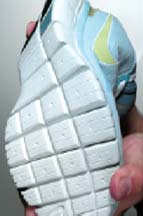
In the world of running shoes, the trend has been toward more cushion, more support, more comfort. Think Air, think Shox. But, to a small group of running coaches and foot specialists, modern athletic shoes are doing to feet what plush living room sofas and TV remotes have been doing to people’s asses: making them lazy, physically underdeveloped and more prone to injuries.
A few years ago when Nike was looking for the next big advance in running shoe design, they asked some of the world’s most respected track and field coaches for advice. A common response must have made their heads spin a little: We don’t need any more shoe, we need less shoe, in fact, maybe we need no shoe. Give us the bare human foot.
 Legendary Stanford track coach Vin Lananna said, “I believe that athletes that have been training barefoot run faster and have fewer injuries. It’s just common sense.” Vin regularly put his athletes through their paces barefoot on the grass of the university’s practice golf course. Other coaches agree, and point to the foot/ankle strength and resistance to injury seen in African and Caribbean runners who have grown up playing and running barefoot much of the time.
Legendary Stanford track coach Vin Lananna said, “I believe that athletes that have been training barefoot run faster and have fewer injuries. It’s just common sense.” Vin regularly put his athletes through their paces barefoot on the grass of the university’s practice golf course. Other coaches agree, and point to the foot/ankle strength and resistance to injury seen in African and Caribbean runners who have grown up playing and running barefoot much of the time.
So, the research and development team at Nike set out to make a shoe that acted like it wasn’t there; one that trained and worked the foot as nature intended. What’s the point, you may ask? Why not just train in your bare feet? Well, that’s fine if you have a finely groomed golf course to run on, but most athletes train in the street, in the gym, on the track, or out on the trails. This still calls for a shoe that not only offers protection from glass and pebbles, but also from the strike of the foot on hard bruising surfaces.
 The first step was to measure exactly what happened to the bare foot when it ran: what the contact areas were between the foot and the ground, how the ankle and toes moved. Once they collected the data, the next step was to create a shoe that could reproduce the natural foot movement. The design team, led by Toby Hatfield and Eric Evar, struggled through innumerable concepts and finally came up with an entirely new kind of shoe. Deep slices in the sole, virtually no ankle support and room for the toes to spread out and move; all head-turning designs. Then it was off to testing again, to make sure the shoe really imitated barefoot running. There was a lot of “back to the drawing board” fine tuning but eventually the Nike Free was created and ready for real-world testing.
The first step was to measure exactly what happened to the bare foot when it ran: what the contact areas were between the foot and the ground, how the ankle and toes moved. Once they collected the data, the next step was to create a shoe that could reproduce the natural foot movement. The design team, led by Toby Hatfield and Eric Evar, struggled through innumerable concepts and finally came up with an entirely new kind of shoe. Deep slices in the sole, virtually no ankle support and room for the toes to spread out and move; all head-turning designs. Then it was off to testing again, to make sure the shoe really imitated barefoot running. There was a lot of “back to the drawing board” fine tuning but eventually the Nike Free was created and ready for real-world testing.
Earlier this year, Faze Magazine was in Germany at the University of Cologne for the results of a season-long research study of university track athletes that showed enhanced performance and speed by training in the Nike Free shoes. One key point is that Nike Free is a “training shoe,” just like running with dumbbells or running at high altitudes might develop some aspect of your fitness, Nike Free and barefoot training are tools to make you stronger.
But as a training shoe, even in the off-season during our cold Canadian winters, the Nike Free can help you regain the competitive edge that evolution and natural selection have given us.


Comments are closed.